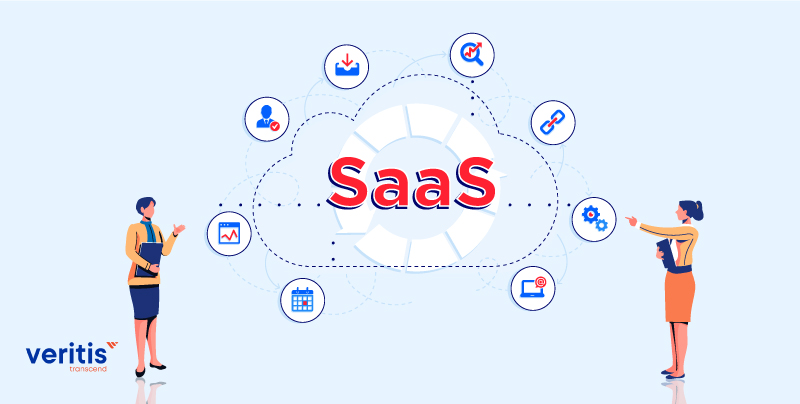
SaaS is something you may hear of from time to time. But, what exactly is that? Software as a Service (SaaS) is an approach where you don’t have to buy software and possess it permanently. Instead, whatever software packages you need will be provided to you on a pay-as-you-go basis.
So, instead of saddling yourself with the software even when you don’t need it, SaaS allows you to rent the software for the required duration. The offering also wicks away licensing issues and compliance issues as they are taken care of by the SaaS provider or the MSP that you have roped in.
While it may give you the impression that these software packages, which you would seek once in a blue moon, SaaS is something that most companies regularly use across the world, the SaaS usage not only provides you software that is ready to be used but also gives you control over your hardware as you get to configure the hardware which would support the software.
In addition, these SaaS models add value to your business with their simplistic subscription model. So, in this blog, we shall explore why should go for SaaS tools are and what tools are preferred for what services.
Advantages of Using SaaS Tools

Gone are the days when you would have to bargain and cough hefty prices on software packages that would later become redundant. Instead, this saves you time by allowing you to use the latest solutions installed and maintained by the MSP.
The software you would rope in would allow you to share it with numerous clients, and you would not have to configure the software every time you share with these SaaS tools. This option saves you time and money. And, given the easy management of the tools, the tools are easily scalable, which facilitates you to further your business goals better than before.
Today, we have plenty of SaaS tools for any and almost every task. This is both a welcome and unwelcome development as the former gives you a choice to use whichever tool you want, but the extreme variety of tools would confuse you. The latter shall only set you back by eating away your time, and should you choose wrong, you will be incurring unwanted expenses. So, to avoid that, let’s have a look at the tools.
Useful Link: Top 10 DevOps Tools to Pick for Your Business
What makes these tools ‘Best’?

In the current day, speed and reliability are key aspects that make them good. But, the ‘best’ should allow innovation through collaboration and have the capacity to shoulder various essential tasks. Whether project management or large-scale mails, the tools should not flinch when subjected to a large amount of pressure, and they don’t buckle, which sets them apart from the standard tools.
So, let’s dig into the best tools for the most used services.
Useful Link: Best Tools That Revolutionize DevOps
Trello: Project Management Tool

Project management is one of the most crucial aspects of a product. From deciding the rollout of the update to how the product lifecycle should be implemented, a lot of action occurs in project management. Realizing its potential, Trello forayed and made its mark as a SaaS project management tool.
Trello, a popular tool, uses the Kanban method to better and ease the interactions between the project members and vital people. The tool comes along with a board that allows the project members to visualize the roadmap. In other words, every board is divvied into columns, and every column has different processes listed in them. These columns will help the members list and understand what’s done and remain to be completed.
Zoom: Video Conferencing Tool

COVID-19 popularized Zoom, the video conferencing utility you and kids used immensely. The primary advantage was its low latency network and the feature that a great deal could be done with paying a buck. While a paid version of it exists, most users didn’t see the need for it as a lot can be achieved with short-duration calls. However, it is wise to go for the paid version if you see the need for the paid version.
The tool comes with various features which foster collaboration, and it is pretty easy to be used. From screen sharing to participant control, Zoom is one of the most popular collaboration tools, and it works on any platform.
There are other variants, such as MS Teams and Google Meet tools which you can rely upon should you decide not to use Zoom for reasons best known to you.
Slack: Communication Tool

First off, Slack’s notification sound is rather addictive. However, Slack packs more than a notification sounds as it is one of the most preferred communication tools. Its UI makes the chatting and sharing easy, features favored by companies where documents are regularly transferred among themselves and external parties. In addition, one can engage in both video and audio calls which boost collaboration. Be it group creation or its numerous integration; Slack can be your preferred communications tool as it allows you to connect beyond Slack as users can use MS Teams through Slack Connect.
Useful Link: Container Technology Tools for IT Business
Mailchimp: Mailing Tool

Mailchimp is software that allows you to mail to a large set of mail recipients. In addition, the online marketing tool allows you to automate mail deliveries and manage ad campaigns. The tool is compatible with multiple platforms, and various users ranging from freelancers to massive organizations prefer Mailchimp as their mailing tool.
Zendesk: Help Desk Software

Zendesk is the bridge between the company and its customers. While it is used by most companies as to help desk software, Zendesk can also be used for business leads. In plain language, Zendesk is a tool that aims to simplify the client support aspect. It possesses enough capabilities to blend data and engagements from various platforms. One of the offerings from Zendesk is the Sunshine CRM platform which lends a holistic view of the data. However, you should know that there is no free version of the available tool.
Top Document Management Tool: Google Drive

This is a tool that probably doesn’t even need an introduction as most, if not all, have used Google drive at some point. From regular documents to video files to storage of files in any format, one can create a shareable link for viewing and downloading purposes. The drive’s advantage is that one can configure the permissions, which can share from the essential viewing permission and lend the user the permission to download and edit the files.
Additionally, the fast upload and download speeds are pretty reliable. The users get 15 GB of storage, which is quite a lot if you are only indulging in document sharing, but if your files are of massive sizes, you will likely exhaust the 15 GB in no time, and you would have to go to the paid version. Finally, the drive can be used from any OS and requires a browser alone is enough to upload the files.
Salesforce Sales Cloud: Customer Relationship Management tool

DevOps for CRM speeds the agile cycle and assures productivity while developing CRM modules. Salesforce Service Cloud, commonly known as Salesforce Ticketing System, is a flexible CRM that gives customers a 360-degree picture of their business. The capacity to serve huge enterprises and the Salesforce CRM, which contains many configurable features and cases instead of tickets, are two of the tool’s advantages. However, CRM is rather complicated for novice users, and this solution is not suitable for businesses looking for free solutions.
Useful Link: Top 15 AWS Machine Learning Tools in the Cloud
Tableau: Analytics tools

By monitoring performance, marketing analytics tools help firms to oversee, analyze, and govern their marketing operations. As a renowned leader in analytics, Tableau supports people and organizations in becoming more data-driven by demonstrating the ROI of produced software. It works on various platforms and includes complex and basic visualizations like histograms and Gantt charts. Tableau is also a prominent participant as a BI tool because of its drag-and-drop feature.
Another tool worth mentioning is Semrush, a popular SaaS tool for managing internet reputation. The most significant benefit of this application is its efficient platform, which allows you to follow competition information. However, this has the drawback of requiring 100 percent exact search filters for the tool to deliver correct results.
Capping it off
The tools listed here are just some of the best SaaS tools. In addition, various tools are there in the same service. For instance, Zendesk also provides similar tools such as Salesforce Sales Cloud. While that choice eases things greatly, it also consumes a great deal of time, and a poor choice will saddle you with burgeoning bills. These are some of the reasons why one opts for an MSP.
Veritis, the Stevie Award winner, has advised companies of various scales. Whether cloud or IT solutions, Veritis has enough expertise to dole out sublime solutions that shall surpass your expectations. So, reach out to us, and let’s embark on a productive journey.
Explore Cloud Soultions Tools Talk to Our Cloud Consultant
Additional Resources:
- Managing Kubernetes Applications Through Terraform and AWS EKS
- Understanding the Differences Between Deep Learning and Machine Learning
- Top Five Docker Alternatives That Can Boost Your Productivity
- Vertical Scaling Vs. Horizontal Scaling: Which One Should You Opt For?
- Amazon Redshift Vs Azure Synapse Analytics